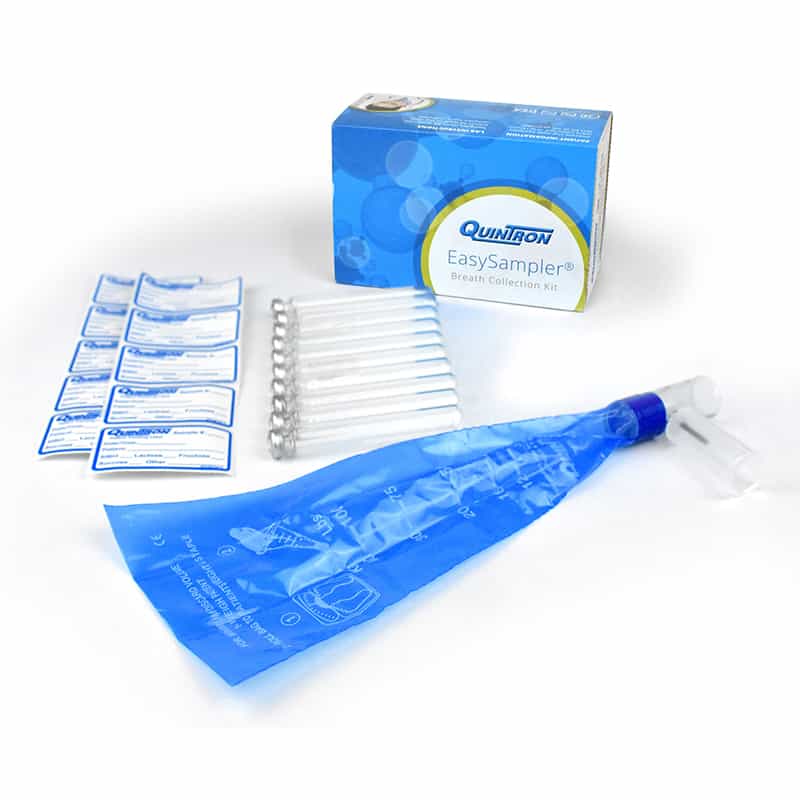SIBO sta per Small Intestine Bacterial Overgrowth e si verifica quando i batteri normali finiscono per vivere in numero eccessivo nell'intestino tenue, causando il caos. Si stima che in media il 60% di tutta la sindrome dell'intestino irritabile sia effettivamente causato da SIBO, con un 84% dei pazienti con IBS che hanno SIBO in uno studio. Puoi leggere di più su SIBO nel nostro Cosa c'è da sapere su SIBO articolo. In questo articolo, esaminiamo cos'è un test SIBO, come sottoporsi al test e quando dovresti considerare di ripetere il test per esso.
Una volta che si verificano gonfiore, diarrea, costipazione, dolore addominale o qualsiasi sintomo SIBO, è importante eseguire un test SIBO. La SIBO può essere una condizione cronica e spesso complicata da trattare. Quindi, prima di iniziare qualsiasi trattamento, è importante sottoporsi al test. Questo perché vogliamo sapere se è la SIBO a causare i sintomi e, in tal caso, che tipo di SIBO hai.
La buona notizia è che ci sono diversi modi per sottoporsi al test SIBO:il test del respiro SIBO e l'aspirato digiunale.
Se hai IBS , disturbi cronici di pancia, celiachia, morbo di Crohn o colite ulcerosa, potresti prendere in considerazione l'idea di sottoporti al test per SIBO. Sono disponibili una gamma di opzioni di trattamento per SIBO , e identificare la sua presenza apre le opzioni di sollievo dai suoi sintomi associati. La buona notizia è che ci sono un paio di modi diversi per essere testati, che esploreremo di seguito.
Attualmente la SIBO può essere testata utilizzando diversi metodi tra cui il test del respiro e l'aspirato digiunale.

Un test del respiro SIBO non è invasivo, facile da eseguire, può essere eseguito a casa o in clinica ed è il metodo più comune per testare la SIBO. Funziona misurando l'idrogeno e/o il metano nell'alito a intervalli di tempo specifici, per un periodo di tempo, dopo che una persona ha bevuto una soluzione di zucchero (lattulosio o glucosio). Puoi fare questo quiz online gratuito per determinare la probabilità che SIBO sia presente prima di ordinare un test.
Una persona è considerata positiva all'idrogeno SIBO se ha un aumento di 20 ppm (parti per milione) rispetto al valore precedente più basso entro i primi 100 minuti.
Una persona è considerata positiva per SIBO metano se ha un aumento di 12ppm rispetto al valore precedente più basso entro i primi 100 minuti.
Se l'aumento si verifica durante 100-120 minuti per l'idrogeno o il metano, questo è considerato un risultato limite.
Alcuni pazienti sperimentano livelli basali elevati. Alcuni medici lo interpretano come un risultato positivo del test. Con il SIBO a metano, questo è particolarmente vero poiché una linea di base alta e un aumento anticipato sono un modello standard di metano. Una preparazione impropria può essere indicata quando i livelli di gas scendono dopo un valore basale elevato e continuano a ridursi o rimanere bassi durante le prime due ore.
Affinché i risultati del test del respiro SIBO siano affidabili, è necessario attenersi a quanto segue.
Un mese prima: Nessuna colonscopie, studi sul bario, colon o uso di antibiotici.
Una settimana prima: Stop a tutti i probiotici, prodotti contenenti probiotici (Es. Yogurt, cibi fermentati), antimicrobici a base di erbe.
Un giorno prima: Stop lassativi, coadiuvanti digestivi (es. enzimi, acido cloridrico), integratori non essenziali. Segui la dieta di preparazione e 12 ore di digiuno.
Una dieta semplice a basso contenuto di carboidrati e fibre fermentabili deve essere seguita 24 ore prima dell'inizio del test. Se una persona è stitica, deve seguire la dieta per 48 ore.
Ogni laboratorio ha cibi consentiti leggermente diversi, ma generalmente includono uova, pesce bianco, pollo, tacchino, riso bianco, formaggio a pasta dura, uova, brodo di carne chiaro (prodotto senza ossa e verdure), olio d'oliva e olio di cocco per la cottura, sale e pepe per condire, tè e caffè neri deboli e acqua naturale. Se non ti vengono fornite le istruzioni dietetiche prima del test, ti consigliamo di contattare la struttura per confermare ciò di cui hanno bisogno in modo da non distorcere inavvertitamente i risultati.
Oltre alla dieta, è necessario un digiuno di 12 ore immediatamente prima del test per consentire al cibo di transitare attraverso l'intestino tenue e lasciarlo relativamente vuoto.

Le 24 ore prima del test potrebbero essere così:
Giorno 1:
7: Uova strapazzate con una tazza di tè nero o caffè debole.
10: Tazza di brodo di carne caldo.
13: Filetto di pesce alla griglia con riso al gelsomino o basmati.
16: Tazza di zuppa a base di brodo di carne e riso al gelsomino o basmati.
19:00: Pollo alla griglia al gelsomino o riso basmati.
19:30 - 7:30: No cibo. Solo acqua.
Giorno 2:
6:30 fino alla fine del test: Vietato fumare (o fumo passivo), niente esercizio, niente dormire. Puoi lavarti i denti normalmente.
7:30 - 10:30: Test del respiro SIBO. Piccole quantità di acqua naturale possono essere sorseggiate durante la finestra di test.
dalle 10:30 in poi: Riprendi a mangiare normalmente.
"Fare un test del respiro SIBO mi ha dato tranquillità. Ottenere una diagnosi SIBO significava che finalmente sapevo cosa non andava nel mio intestino. Il mio medico aveva un piano in atto e iniziamo trattamento immediatamente. Alla fine, ero sulla strada per la guarigione dai miei sintomi intestinali debilitanti.
Rebecca Comes
Il test del respiro SIBO ha offerto alle persone di tutto il mondo l'opportunità di ottenere risposte su ciò che sta succedendo nel loro intestino.

Facile da fare






















Conveniente






















Relativamente veloce da fare (3 ore)






















Ottieni risultati rapidamente






















Test diagnostico SIBO più comune






















Può diagnosticare sia idrogeno che metano SIBO






















Non adatto a persone che non possono soffiare in un tubo






















Impossibile diagnosticare l'acido solfidrico SIBO






















La soluzione di zucchero può peggiorare temporaneamente i sintomi






















Il lattulosio è un prodotto soggetto a prescrizione negli Stati Uniti






















Glucose only measures SIBO in first 3 feet of small intestine






















Requires proper preparation, fasting for 12 hours and 3 hours to do the test






















May provide false negative and false positive results in some patients due to improper preparation or other conditions affecting gut transit time
Want to learn more about SIBO breath testing? Listen to my podcast interview with Eric Hamilton from QuinTron Instrument Company, the leading manufacturers of the SIBO breath testing equipment.
An aspirate can be taken from the second part of the small intestine. This can be performed by an endoscopy in-clinic, generally under anaesthesia or sedation. A sample is taken and the culture is grown to determine what bacteria are present.
Questo test è invasivo, costoso e difficile da trovare perché richiede un professionista medico altamente qualificato per eseguire il test. Per questi motivi, non è comunemente usato.
It can also produce false-negative results if the bacterial overgrowth is further down the small intestine, where the sample hasn't come from, if the sample size was too small, or if the bacteria that was collected can't be cultured.
Your doctor's office will have specific instructions for preparing for a jejunal aspirate, but they may be similar to the SIBO breath test prep.






















Considered gold standard by some practitioners






















Invasive






















Expensive






















Requires sedation or anaesthetic






















Time consuming






















Requires a gastroenterologist to perform procedure






















Greater risks as a medical procedure






















Can produce false negative and positives results
Stool testing can be very informative about a person's large intestine health and their broader GI health. It can show if there are imbalances or pathogenic organisms. However, it cannot diagnose SIBO as by its very nature, the stool test cannot determine where the bacterial overgrowth is occurring. The overgrowth could be from the large intestine, the small intestine or both.
If it is not possible for a person to undertake a breath test, such as for very young children who cannot blow into a tube, this can be a good indicative starting point until a breath test can be taken.
Batteri e funghi producono acidi organici che vengono escreti nelle urine. A urine organic acids test measures the level of organic acids that you have excreted, giving you an indication that you may have a yeast or bacterial overgrowth somewhere in your body.
Tuttavia, come il test delle feci, non è in grado di individuare esattamente dove the overgrowth is occurring, and for this reason, cannot be used to definitively diagnose SIBO.
Researchers and breath test manufacturers are working on a commercially suitable test for Hydrogen Sulfide SIBO, which should be available in the coming years. There may also be exciting developments with the use of smart devices, which are swallowed and can take samples along the entire length of the small intestine tract.
A positive SIBO test means you either have hydrogen, methane, or suspected hydrogen sulfide SIBO. The next step is to find a practitioner who is experienced in treating SIBO. A SIBO specialist will recommend a course of treatment based on what SIBO you have, what type of treatment you feel most comfortable with and what they clinically see delivers the best results. There are 3 current SIBO treatment protocols:antibiotics, herbal antimicrobials and the Elemental Diet.
Some patients only need to do one of the three treatment options to recover from SIBO. However, for two-thirds of people, SIBO is a chronic, recurring condition and multiple rounds are required of one or all three of the available treatments.
Remember, no two people are the same. We’re all on different journeys so you need to make sure that you’re with the right practitioner who helps you to understand your condition, and who has the expertise and a depth of knowledge required to treat SIBO.
If, after a round of treatment, you don't feel a noticeable improvement, then it may be worth considering re-testing for SIBO. This can provide your practitioner with useful information, such as whether the treatment was effective, which gas(es) is still present and what treatments should be utilised next.
However, it is important to remember that a person is more than their SIBO test results. How you feel is more important than what a test result says. If you feel better, that is a more important metric to hold onto. I have had many SIBO coaching clients who have tested positive for SIBO, yet feel remarkably better than when they first started treatment.
If you found this article on how to get tested for SIBO helpful, I would love to hear your thoughts. Simply leave a comment in the comments section below.
"I have chronic, relapsing SIBO. I listen to my body and let it guide me with symptoms. I re-test for SIBO on occasion when I want information on whether I have hydrogen, methane or both, what my gas levels are like, and what treatment I need to consider. I let my body tell me how I am actually feeling, not a test result.
Rebecca Coomes
Pin1383 Shares Diagnosi, gestione e trattamento dell'emorragia rettale
Il sanguinamento rettale acuto, noto anche come sanguinamento gastrointestinale inferiore (GI), è la perdita di sangue fresco dal colon. Il sangue nelle feci può derivare da una serie di cause gener
Diagnosi, gestione e trattamento dell'emorragia rettale
Il sanguinamento rettale acuto, noto anche come sanguinamento gastrointestinale inferiore (GI), è la perdita di sangue fresco dal colon. Il sangue nelle feci può derivare da una serie di cause gener
 Probiotici SCD:cosa devi sapere
Alcuni mesi fa stavo ascoltando un podcast di Chris Kresser e ha detto qualcosa che ha scosso il mio etch-a-sketch. Capisci cosa intendo vero? Uso quel termine ogni volta che imparo qualcosa che can
Probiotici SCD:cosa devi sapere
Alcuni mesi fa stavo ascoltando un podcast di Chris Kresser e ha detto qualcosa che ha scosso il mio etch-a-sketch. Capisci cosa intendo vero? Uso quel termine ogni volta che imparo qualcosa che can
 Lo stress può spiegare problemi digestivi nei bambini con autismo
Ultime notizie sulla neurologia Altre prove collegano la mono alla sclerosi multipla Anche un piccolo esercizio può aiutare a rallentare il Parkinson Il farmaco potrebbe aiutare ad alleviare le richi
Lo stress può spiegare problemi digestivi nei bambini con autismo
Ultime notizie sulla neurologia Altre prove collegano la mono alla sclerosi multipla Anche un piccolo esercizio può aiutare a rallentare il Parkinson Il farmaco potrebbe aiutare ad alleviare le richi